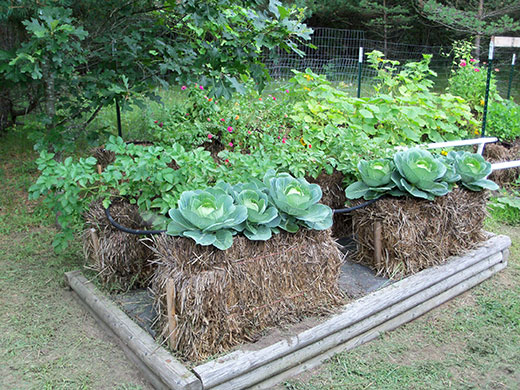
Straw bales can serve as bedding and a growth medium for a variety of garden goodies. (Photo courtesy of Joel Karsten, Washington State University, Using Cereal Straw Beds in Home Gardens)
Straw bales an intriguing option for Kansas home gardeners
Straw can serve as a gardening bed and the growth medium
May 7, 2020
MANHATTAN, Kan. – Kansas State University horticulture specialist Ward Upham says Kansans curious about straw bale gardening are living in a pretty good place to give it a try.
“What better place to try this than in Kansas, where we have an abundance of straw,” Upham said.
Straw bales are made from the stalks of such crops as wheat and barley and can give home gardens a boost, especially in areas where soil conditions are less than ideal for growing herbs and vegetables.
The small rectangular bales, about two feet high, can be used as raised beds in the yard so that no additional soil is needed. They can be placed just about anywhere, Upham said, even on concrete or asphalt. “Just make sure there is plenty of sun and watering is convenient,” he said.
Straw bales are different from hay bales, which are made from grass. Straw bales serve as both the gardening bed and a growing medium and is considered an inexpensive method for growing vegetables.
Upham says straw bales must first be conditioned for 10 days before planting.
“Water the bales and keep them wet for three days,” he said. “The bale will start to heat up as it breaks down. Then, on days 4-6, sprinkle fertilizer on the top of each bale with 1 cup of ammonium sulfate or ½ cup of urea; and on days 7-9, continue fertilizing, but cut the amount in half.”
On the tenth day, he said, stop fertilizing but keep the bale moist. Check the heat on top of the bale daily after 10 days. “When the temperature drops below 100, your crops can be planted into the bale.”
He described two methods for planting:
- Pocket method – make a hole for each plant several inches deep and fill with a growing medium, such as well-aged manure, compost or potting soil.
- Flat bed method – cover the top of the bale with 3-4 inches of growing medium.
“Watering is the most challenging aspect of straw bale gardening,” Upham said. “The straw dries quickly, so if you can install a drip irrigation system on a timer, that is a good way to keep the bales wet. Gardeners may also use soda bottles or milk jugs to water by poking drip holes in the lid, filling with water, and then turning it upside down next to the target plant.”
As a guideline, the number of plants that can be planted in one bale:
- Cantaloupe: 2
- Cucumber: 3-4
- Peppers: 3-5
- Winter squash: 2
- Summer squash: 2-3
- Tomatoes: 2-3
Upham credited the extension horticulture program at Washington State University for an “excellent publication that includes much more detail and images” on straw bale gardening. That publication, Using Cereal Straw Bales in Home Gardens, is available free online.
Upham and his colleagues in K-State’s Department of Horticulture and Natural Resources produce a weekly Horticultural Newsletter with tips for keeping yards healthy and beautiful year-round. The newsletter is available to view online or can be delivered by email each week.
Interested persons can also send their yard-related questions to Upham at wupham@ksu.edu.

